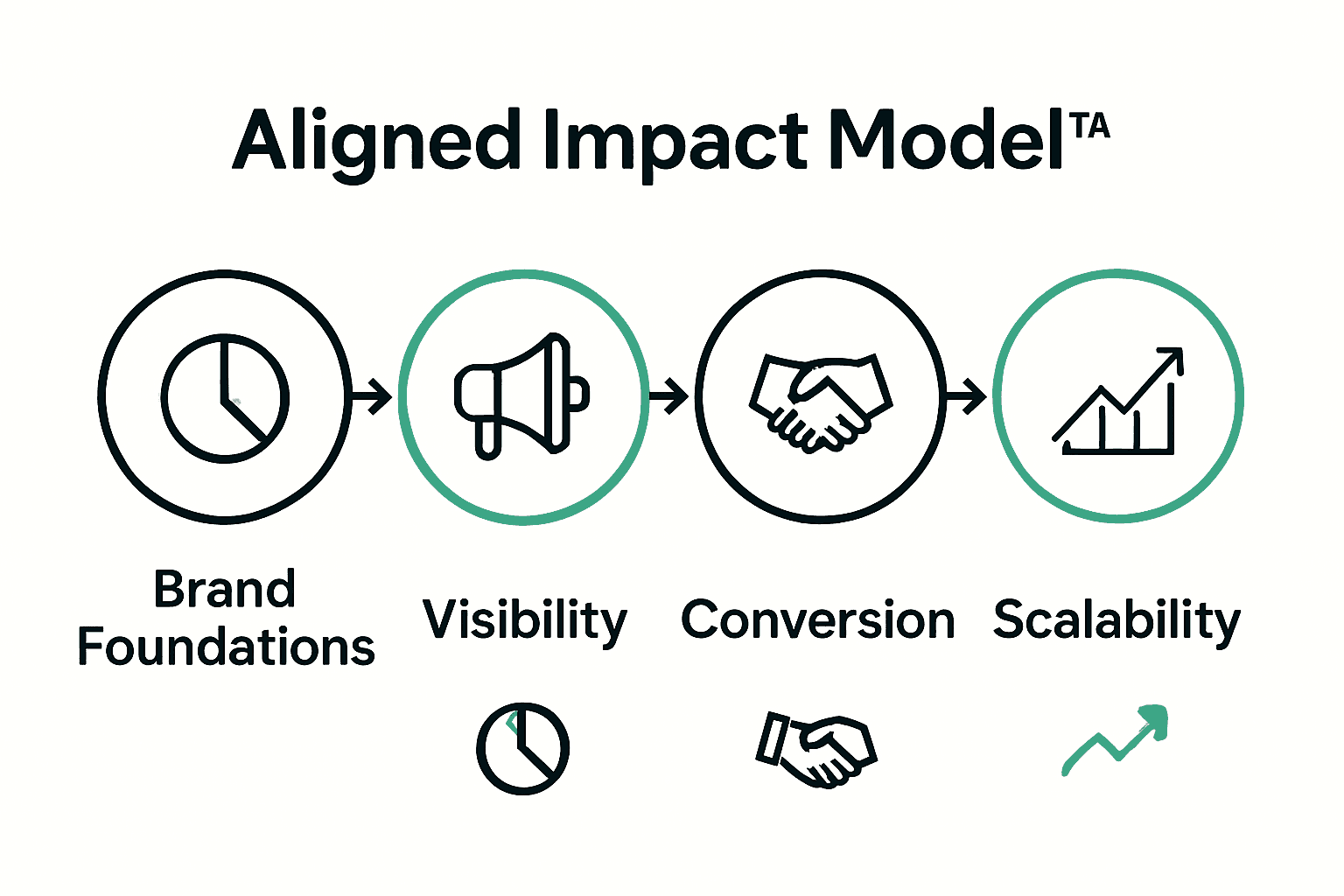Why Invest in Branding: Complete Guide for Growth

Discover how to optimize marketing budget step by step to achieve sustainable growth, avoid waste, and align spend with what truly drives results.

Over 50 percent of marketing budgets fail to deliver measurable returns because they are not aligned with clear goals or a well-defined audience. Every dollar counts when trying to grow your business, so guessing your way through spending often leads to wasted resources and missed opportunities. By following a structured approach, you can turn your marketing investment into a real driver of business growth and see stronger results with less wasted effort.
Successfully optimizing your marketing budget starts with two critical foundational elements: crystal clear business goals and a precisely defined target audience. This step transforms your marketing from scattered attempts to strategic, purposeful investment.
Begin by writing down your specific business objectives. Are you aiming to increase revenue by 20% this quarter? Launch a new product line? Expand into a different market segment? Your goals need to be concrete and measurable. Dive into our guide on how to set marketing goals that drive real business growth to ensure you are setting targets that truly matter.
Next, develop a detailed profile of your ideal customer. This isn’t about creating a generic demographic snapshot but understanding the deep psychological drivers of your audience. Research their pain points, aspirations, and decision making patterns. What keeps them up at night? What solutions are they desperately seeking? A precise audience understanding allows you to craft marketing messages that resonate powerfully and convert more effectively.
Warning: Avoid the common trap of assuming you know your audience without actual research. Talk to existing customers, conduct surveys, analyze customer interaction data. Your marketing budget will thank you for this upfront investment in understanding.
As you complete this foundational step, you are now ready to align your marketing resources strategically. The next phase will transform these insights into a targeted marketing approach that maximizes every dollar spent.
This step involves a comprehensive review of your current marketing investments to identify inefficiencies, eliminate wasteful spending, and strategically reallocate resources. By meticulously examining your marketing systems, you will uncover opportunities to maximize your budget and drive sustainable growth.
Start by gathering all your marketing expense records from the past 6 to 12 months. Create a detailed spreadsheet that categorizes every marketing expenditure channels like digital advertising, social media, content creation, email marketing, and offline promotional activities. Learn more about building effective marketing systems for entrepreneurs to help streamline this process.
Analyze each marketing channel for its return on investment. Which channels are generating actual leads and conversions? Which ones are consuming budget without delivering meaningful results? Look beyond surface level metrics. A social media campaign might have high engagement but low conversion rates while a targeted email sequence could be generating significant revenue with minimal investment.
Warning: Be ruthlessly honest during this audit. Emotional attachment to past marketing strategies can blind you to their actual performance. Just because a tactic worked once does not mean it continues to deliver value.

As you complete this audit, you are now ready to make data driven decisions about reallocating your marketing budget. The next step will involve designing a more strategic and focused marketing approach that aligns with your business goals.
Now that you have audited your current marketing spend, it is time to strategically allocate your budget towards channels and tactics that deliver the most significant results. This step transforms your marketing from a scattered approach to a laser focused strategy that maximizes every dollar invested.
Start by ranking your marketing channels based on their actual return on investment. Not all channels perform equally some will generate substantially more leads and conversions than others. Learn how to build a marketing strategy that delivers real results to help guide your decision making process. Focus on channels that not only generate volume but also attract high quality leads aligned with your ideal customer profile.
Consider using data clustering techniques to identify patterns in your marketing performance. Advanced research suggests using algorithmic approaches to systematically evaluate and prioritize marketing channels. This means looking beyond surface level metrics and diving deep into conversion rates customer acquisition costs and long term value of leads generated through each channel.
Warning: Avoid the temptation to spread your budget evenly across all channels. Concentration is key. Invest heavily in 2 3 channels that consistently demonstrate strong performance rather than diluting your resources across multiple underperforming platforms.
As you complete this prioritization process you are now ready to develop a targeted marketing approach that focuses your resources where they will create the most significant impact. The next step will involve creating a strategic implementation plan that turns these insights into actionable marketing tactics.
The Aligned Impact Model™ provides a strategic framework to transform your marketing budget from a random expense into a purposeful investment that drives sustainable business growth. This step will help you map your financial resources directly to each stage of the model ensuring every dollar contributes meaningfully to your business objectives.
Explore our guide on developing an aligned brand strategy workflow to understand how to connect your budget with strategic business outcomes. Begin by allocating resources across the model’s key stages brand foundations visibility conversion and scalability. Each stage requires different levels of investment based on your current business needs and growth objectives.
Start by assessing your current positioning in the model. Are you still developing foundational brand elements? Do you need more visibility tactics? Or are you ready to optimize conversion strategies? Distribute your budget proportionally to address the most critical gaps in your current marketing ecosystem. This might mean investing more heavily in brand positioning early on or shifting funds towards conversion tactics as your business matures.

Warning: Avoid treating the Aligned Impact Model™ as a rigid template. Your budget allocation should be dynamic flexible and responsive to your evolving business landscape. Regularly review and adjust your investments to ensure they continue driving meaningful results.
As you complete this alignment process you are now prepared to implement a marketing budget that is not just a cost center but a strategic growth engine. The next step will involve creating specific implementation plans that bring this strategic vision to life.
This final step transforms your marketing budget from a static allocation to a dynamic growth engine. You will establish a systematic approach to continuously evaluate track and optimize your marketing investments ensuring sustained business growth and maximum return on every dollar spent.
Learn how to create a marketing strategy that consistently delivers results and build a robust measurement framework. Implement a quarterly review process where you analyze key performance indicators such as customer acquisition cost conversion rates revenue generated and overall marketing efficiency. Look beyond surface level metrics and dive deep into the qualitative and quantitative data that reveal true marketing performance.
Develop a scoring system that helps you objectively assess each marketing channel and tactic. Assign weighted scores based on factors like lead quality customer lifetime value and alignment with your business objectives. This approach allows you to make data driven decisions about scaling successful strategies or pivoting away from underperforming investments. The goal is to create a feedback loop that continuously refines your marketing approach and maximizes resource allocation.
Warning: Avoid analysis paralysis. While measurement is critical do not get stuck in endless data collection. Set clear review intervals establish key metrics upfront and be prepared to make swift decisive adjustments based on your findings.
As you complete this final step you have transformed your marketing budget from a random expense into a strategic growth mechanism. You now have a systematic approach to investing optimizing and scaling your marketing efforts with precision and confidence.
Optimizing your marketing budget for sustainable growth requires more than just cutting costs or chasing quick wins. The real challenge lies in aligning every dollar with clear business goals and deeply understanding your ideal audience — just like the article describes with concepts like The Aligned Impact Model™ and channel prioritization. If you are feeling overwhelmed by scattered marketing efforts or unsure where to invest next, you are not alone. Many entrepreneurs struggle with creating marketing systems that balance strategy with meaningful, long-term impact.
At Reasonate Studio, we partner with small business owners to take these exact challenges off your plate. Our proven framework not only helps you clarify your brand foundations and refine your visibility tactics but also ensures your budget drives measurable results aligned with your vision. The studio’s unique approach combines strategic insight with empathetic guidance so you gain confidence and avoid costly mistakes—turning your marketing budget into a powerful growth engine.
Ready to move beyond trial and error? Explore how our strategic processes can transform your marketing spend into sustainable momentum today.

Get started now and experience the clarity and focus your business deserves. Learn more about our hands-on coaching and design solutions that match your business stage at Reasonate Studio. Take control of your marketing journey with expert guidance tailored to where you are right now.
To clarify your business goals, write down specific objectives like increasing revenue by 20% or launching a new product line. Break these goals into measurable targets to guide your marketing decisions.
To understand your target audience, conduct surveys, analyze customer interaction data, and talk to existing customers about their pain points and aspirations. Spend time gathering this information to develop a detailed customer profile that resonates with your marketing strategies.
To audit your current marketing spend, gather your marketing expenses from the last 6-12 months and create a detailed spreadsheet categorizing each expenditure. Analyze the return on investment for each channel to identify which ones are performing well and which are not contributing to your goals.
Focus on high-impact channels by ranking them based on their return on investment, rather than spreading your budget evenly across all options. Invest heavily in 2-3 top-performing channels to ensure your marketing efforts yield greater results.
To align your marketing budget with the Aligned Impact Model™, evaluate your current business needs and allocate resources to each stage of the model: brand foundations, visibility, conversion, and scalability. Adjust your budget based on the most pressing gaps in your marketing strategy.
Establish a quarterly review process to assess key performance indicators like conversion rates and customer acquisition costs. Use a scoring system to objectively evaluate each marketing channel and make data-driven decisions about where to scale or adjust investments.